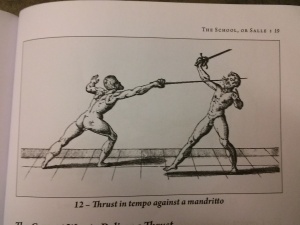At this point, defense against cuts has already been pretty thoroughly covered in the recent discussion of tempo and in the discussion of Second Giganti, in chapters I, II, and III. What follows is a rough summation of those lessons.
When discussing cuts it’s always worthwhile to remember Di Grassi’s (and others’) admonition that the thrust is faster than the cut. It covers less space and uses fewer muscles. This is why it eventually supplanted the cut as the primary strike in combat1.
Countering cuts:
Thrusts are smaller tempi. In general, if you can counter a cut with a thrust, it is a good idea to do so. All rules regarding contratempo attacks apply, all the same tempi are still available. As a result, fighting cut and thrust is the same as fencing, in Italian Rapier, with the added benefit of being able to deliver a cut when positioning allows.
The primary response to a cut is to impose your forte in the way of their foible and lunge. Prima becomes especially useful here since it counters high cuts while keeping the point online. This contratempo attack-with-defense is made even easier in most C&T fights because fighters tend to start with their points off-line or bring them off-line to begin the cut. While it’s tempting to believe this makes it more difficult to gain their blade, it in fact makes it easier. Their line of attack is made clear (what direction is the edge of their blade facing?), the time required to change to a new line is even larger.
All of these counters to cuts also work against fighters who like to use beats against your blade (a beat is just a cut to the blade). The most elegant response is to lunge into the beat so they end up on your forte, and continue forward to land the kill. Here, though, since the attack is against the sword and not your person, a cavazione is the easier counter to execute.
All of the same counters against thrusts work against lunges. Cuts can be voided, though since the blade has lateral motion voids must be away from the plane of that strike, either backwards to pull the target out of measure or at an angle to duck below the cut.
Delivering cuts:
In some cases, you may end up needing to parry or counter-cut into an incoming cut. This may pull your blade out of position to deliver a thrust. If it does, tramazzone (sometimes called stramazzone), cuts made from the wrist, are about the only cut worth throwing, since they cover relatively little distance and can be directed against small openings easily. In period these were used to damage the tendons of the sword hand and forearm, or to land cuts across the face and throat, or to damage the muscles of the leg and the tendons of the knee, as these are all targets quickly reached from a neutral guard. The added benefit of a tramazzone is that it does not move your forte much out of position, maintaining the counter-guard so that you can defend against the cut while striking in contratempo
If you have successfully passed on the outside or inside and seized control of your opponent’s blade, but your point has ended up out of position to deliver a thrust, cuts are a serviceable alternative. This can also be used if you have voided a vigorous attack from an opponent (especially voids to the inside, if you have gained their blade in the process with yours above theirs, you are already in position to strike their face).
Aggressive closers are also best discouraged by beats and cuts. Giganti talks about those who charge throwing beats and thrusts without any concept of tempo and measure. His advice is to beat their blade strongly away then stab them. Even should an opponent succeed in beating your sword aside, the cut permits a one tempo attack from any position as soon as they break their engagement, and footwork and bodywork can just as easily defend against a cut during this tempo as against a thrust.
1Though even in those forms we think of as cut-centric (e.g. German longsword) thrusts were an essential element and when armor was involved, the primary killing strike. In “La Jeu de la Hache,” a Burgundian pole axe manual, most plays involve countering the opponent’s blow with a thrust. After all, a thrust to the weak spots of armor was the way to end a fight in one strike, which is always the goal. For this reason the ban on thrusting in Battle of the Nations and its kin reduces those to a sport, not a simulation of combat.

Leave a Reply